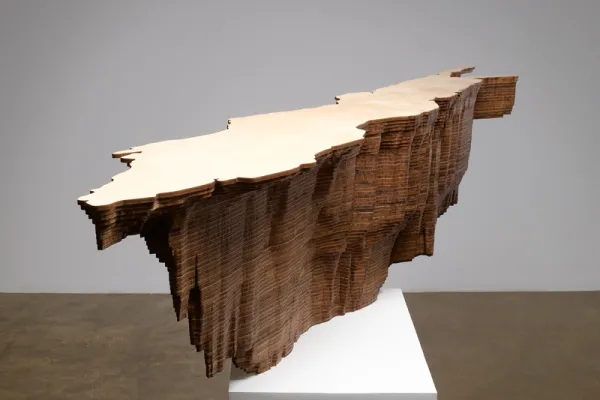‘Mappings’: Maya Lin Exhibition on Display at SCMA
Smith Arts
Published February 28, 2022
Most people know Maya Lin as an accomplished architectural designer connected to Smith by way of her redesign of Neilson Library. Through August 7, visitors to the Smith College Museum of Art will also have a chance to view “Maya Lin: Mappings,” a collection of Lin’s artwork poignantly commenting on climate change and the relationships humans have with the environment.
Composed of various materials including atlases, steel pins and plywood, the 21 pieces in the exhibition—the idea for which was born from her work on the new Neilson—come together to open up a dialogue between the artist and the viewer about place and space.
“We chose the theme of ‘mappings’ because a map situates you within a space,” says Aprile Gallant, associate director of curatorial affairs and senior curator of prints, drawings and photographs at SCMA. “It tells you where you are and where you might be headed.” A central focus of “Mappings”—climate change—takes this notion and amplifies it to a global scale.
“Each of my works originates from a simple desire to make people aware of their surroundings,” Lin has said of her work. “Not just the physical world but also the psychological world we live in.”
The collection features pieces that offer direct commentary on climate change, as well as works that speak to physical spaces and the environment more broadly on the topics of ice, land and water.
An interactive, online component of the exhibition, called “What Is Missing?” invites viewers to share the ways in which they personally have seen the environment change over their lifetime. A key piece of the show, “What Is Missing?” also documents real-life environmental disasters and successes. Lin has called “What Is Missing?” her “last memorial.”
Other works on display include “Pin River—Sandy,” created from more than 17,000 stainless steel pins. The piece traces the boundaries of the flooding along the East Coast caused by Hurricane Sandy in 2012. Measuring over 10 feet long, the work creates an impact by allowing museum-goers to conceptualize the damage done by such storms.
Widely applicable to a number of academic fields, there are plans for several courses at Smith—including those in the environmental science and policy, landscape studies and art history departments—to integrate the show into their syllabi this spring.
The conscientiousness Lin displays in “Mappings” about how we interact with and impact nature is reflected in the new Neilson as well. Wherever possible, building materials such as wall panelings were salvaged from the previous building and integrated into the new space. Lin even designed custom furniture made from a felled elm tree that had to be removed during construction of the new library, created a sculpture of the Mill River out of recycled glass marbles to greet patrons in the building’s lobby and incorporated natural sunlight throughout the library’s core.
“Neilson is situated within the landscape,” Gallant says. “It’s very responsive. Her architecture is also so environmentally sensitive.”
“Some people may go into a museum thinking that what they’re viewing has no connection to their daily life,” Gallant explains. “I think that’s just not true. I hope ‘Mappings’ provokes a desire for people to learn more about the environment and the impact humans have on it.”
“Maya Lin: Mappings” was curated by the Smith College Museum of Art with support from Maya Lin Studio. The exhibition is supported by the Ann Weinbaum Solomon ’59 Fund and the Judith Plesser Targan ’53 Fund.
Red Sea (Bodies of Water series) Maya Lin. American, born 1959. Copyright Maya Lin Studio, courtesy of Pace Gallery. Photograph by Kerry Ryan McFate
